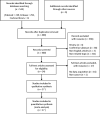Increased CD9 expression predicts favorable prognosis in human cancers: a systematic review and meta-analysis
- PMID: 34493282
- PMCID: PMC8422728
- DOI: 10.1186/s12935-021-02152-y
Increased CD9 expression predicts favorable prognosis in human cancers: a systematic review and meta-analysis
Abstract
Background: CD9 is implicated in cancer progression and metastasis by its role in suppressing cancer cell proliferation and survival. However, the prognostic and clinicopathological significance of CD9 expression is controversial. Therefore, the current meta-analysis was conducted to determine the prognostic and clinicopathological significance of CD9 expression in cancer patients.
Methods: Eligible studies were selected through database search of PubMed, Embase and Cochrane library up to April 5 2020. The necessary data were extracted from the included studies. Pooled hazard ratio (HR) and odds ratio (OR) with 95% confidence interval (CI) were calculated to evaluate the prognostic and clinicopathological significance of CD9 expression in cancer patients.
Results: A total of 17 studies consisting of 3456 cancer patients were included in this meta-analysis. An increased CD9 expression was significantly associated with a more favorable overall survival (OS) (HR 0.47, 95% CI 0.31-0.73, p = 0.001) and disease-free survival (DFS) (HR 0.48, 95% CI 0.30-0.79, p = 0.003). In subgroup analysis of cancer type, an increased CD9 expression was associated with increased OS in breast cancer and digestive system cancer, and with increased DFS in head and neck cancer and leukemia/lymphoma. Additionally, an increased CD9 expression significantly correlated with lower overall stage (OR 0.45, 95% CI 0.29-0.72, p = 0.001).
Conclusion: An increased CD9 expression was associated with favorable survival in cancer patients suggesting that CD9 expression could be a valuable survival factor in cancer patients.
Keywords: CD9; Cancer; Meta-analysis; Prognosis; Survival.
© 2021. The Author(s).
Conflict of interest statement
The authors declare that they have no competing interests.
Figures







References
Publication types
LinkOut - more resources
Full Text Sources
Miscellaneous

